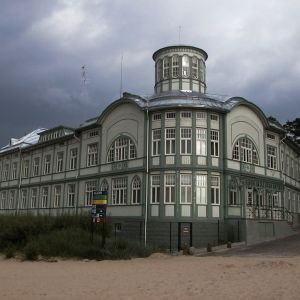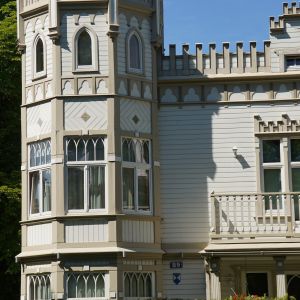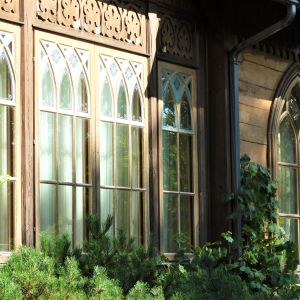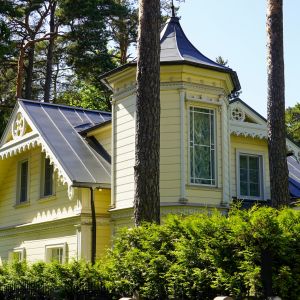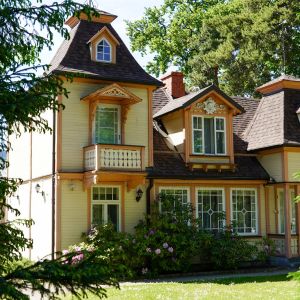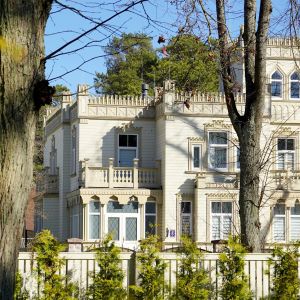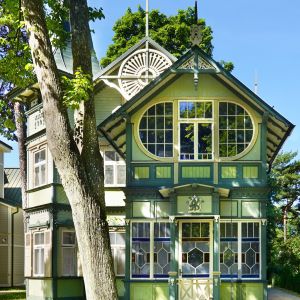The Majori Route

This section of the route leads along what was once the sandy Jūras Street, which has now become Jūrmala’s central architectural axis. Here, alongside the beach, stand majestic historic villas and public buildings — some literally built in the shoreline sand — forming one of the most impressive wooden architecture corridors in Jūrmala. The route invites a leisurely exploration of the coastal villa row and a look into the nearby cross-streets.
Route starting point:
Sea Pavilion (Tirgoņu Street 1) — one of the few buildings constructed directly by the sea → Tirgoņu Street 6 → 18 → Rācenes Public Bath (Pilsoņu Street 1)
Continuation along Jūras Street — the city’s main architectural axis in this section:
→ Jūras Street 6 → 8 → 29 → 30 → 31 → 33 → 38 → 47
Turn onto Konkordijas Street:
→ Konkordijas Street 5 → 19
Additional highlights:
→ J. Pliekšāna Street 5/7 (historic wooden villa, now a museum) → Jaunā Street 3 → 6
Photos: Jūrmala Cultural Space and Environmental Design Centre
Sea Pavilion, Tirgoņu Street 1
Style: Art Nouveau
Volume composition:
- Asymmetrical volume
- High stone terrace
- Decorative retaining wall
- Square tower
Look closer: The building’s richly carved façade is complemented by its high stone terrace and distinctive corner tower, shaping its coastal silhouette. As one of the rare structures built directly on the seafront, it once served as a major public centre in the city.
Construction period: 1909 (Architect: Arturs Medlingers)
Heritage status: Regional cultural monument
Tirgoņu Street 6
Style: Art Nouveau
Volume composition:
- Asymmetrical volume
- Balcony
Look closer: A typical Jūrmala summer villa featuring a prominently wood-carved balcony. Originally built as a gardener’s house adjacent to a grander residence, it has now been fully restored. The balcony carvings combine modern laser technology with traditional craftsmanship — even experts can’t always distinguish which parts are modern.
Construction period: c. 1920; reconstructed in 2023 (Architect: Māris Ārgalis)
Heritage status: Culturally valuable building
Tirgoņu Street 18
Style: Art Nouveau
Volume composition:
- Asymmetrical volume
- Two-storey wooden structure
- Square tower
- Veranda
Look closer: The façade features a two-level veranda with delicate carvings and an oval-framed window that visually expands the central window, giving the building a sense of lightness. The ornate wood carvings — lavish frames, decorative cornices, and pilasters — highlight the villa’s artistic value, making it one of the most significant Art Nouveau wooden architecture examples in Jūrmala.
Construction period: Early 20th century
Heritage status: National architectural monument
Pilsoņu Street 1, Emīlija Rācene Public Bath
Style: Historicism with Art Nouveau elements
Volume composition:
- Asymmetrical volume
- Verandas
- Cylindrical tower with conical roof
Look closer: This rare beachfront boarding house stands out with its impressive cylindrical dome-like veranda and roof extension above the main entrance. A semicircular glass veranda adjoins the entrance portal, which once bore signage for “Emīlija Rācene Bathing Establishment.” After suffering storm damage and unsympathetic modifications during the Soviet era, it was fully restored in 1997 — including the return of original woodworking and entrance details.
Construction period: Early 20th century; restored in 1997
Heritage status: Regional cultural monument
Jūras Street 6
Style: Art Nouveau
Volume composition:
- Asymmetrical volume
- Polygonal tower
- Veranda
Look closer: The façade is adorned with refined wood carvings around the windows and cornices. The slender glazed veranda and graceful small tower add lightness and the typical seaside villa ambiance of Jūrmala.
Construction period: 1913
Heritage status: National cultural monument
Jūras Street 8
Style: Art Nouveau
Volume composition:
- Asymmetrical volume
- Single-storey wooden building
- Mansard roof
- Polygonal tower with a multi-faceted spire and dormers
Look closer: The building stands out for its small architectural forms — a courtyard fountain, a decorative gate pavilion with a tented tile roof, and an elegantly crafted fence create a distinctive entrance composition.
Construction period: 1913
Heritage status: National cultural monument
Jūras Street 29
Style: Neo-Gothic
Volume composition:
- Asymmetrical volume
- Two-storey timber-frame building
- Square tower with a corbel cornice
- Veranda
- Balcony
Look closer: This villa is a striking example of Neo-Gothic wooden architecture, evoking a romanticized medieval castle. Dominant features include parapets in corbel form and a corner turret with mock embrasures, enhancing the fortress-like character. Pointed arch windows and ornate carvings enrich the façade’s rhythm, while the light colour scheme adds elegance.
Construction period: Early 20th century
Heritage status: Regional cultural monument
Jūras Street 30
Style: Traditional Jūrmala summer villa
Volume composition:
- Timber-frame structure
- Symmetrical main façade
- Veranda
Look closer: Distinctive features include semi-circular decorative windows and a sunburst motif.
Construction period: Early 20th century
Heritage status: Local cultural monument
Jūras Street 31
Style: Neo-Classicism
Volume composition:
- Symmetrical volume
- Single-storey wooden building with dormer
- Mezzanine
Look closer: Architecturally more akin to a small manor house in the Riga region than a typical Jūrmala summer house. It illustrates how a wooden residential building was adapted for resort use. Classical influences are seen in the turned half-columns forming a colonnade between the ground floor and mezzanine, and in the fanlight window in the pediment. The original horizontal timber cladding has been preserved.
Construction period: Late 19th century; restored in the 2000s (Architects: Sīlis, Zābers, and Kļava)
Heritage status: Regional cultural monument
Jūras Street 33
Style: Neo-Gothic
Volume composition:
- Symmetrical volume
- Single-storey wooden building
Look closer: The façade features pointed arch windows and an open central porch. Despite an added modern extension, the building retains its historical charm. The reconstruction, titled Sun House, embraces the sun theme — with amber-coloured natural wood façades and a sundial by sculptor Gļebs Panteļējevs. Interior details continue the motif, including sunbeam-inspired glasswork and a fireplace depicting a pharaoh worshipping the sun god Aten.
Construction period: c. 1900; reconstructed in 1998 (Architect: Andis Sīlis)
Heritage status: National architectural monument
Konkordijas Street 5
Style: Neo-Gothic
Volume composition:
- Asymmetrical volume
- Two-storey wooden building
- Three-storey square tower with parapet and corbel course
- Verandas
- Terrace
- Bay window extension
- Balcony
- Ancillary building extensions
Look closer: A representative example of Neo-Gothic in Jūrmala’s wooden architecture. The dominant three-storey tower and broad glazed verandas define its silhouette. Rich façade details include carved corbels, tracery, profiled cornices, and decorative pilasters. Original windows, casings, overlights, and dentils have been preserved across all levels.
Construction period: Early 20th century
Heritage status: Local cultural monument
Konkordijas Street 19
Style: Art Nouveau
Volume composition:
- Single-storey wooden building
- Asymmetrical composition
- Glazed veranda with diagonally positioned tower-like extension (south side)
- Open veranda – porch
- Open loggia with four semi-circular arches (west façade)
- Square tower
Look closer: A picturesque and architecturally refined example of Art Nouveau in Jūrmala. The building’s silhouette is richly articulated, with distinctive Art Nouveau elements. A corner turret with a tented roof highlights the south façade, while the main entrance features an open loggia with semi-circular arches and clover-leaf wood carvings. Stained-glass-style window divisions and vertical boarding below the windows add sophistication. Remarkably, the building retains its historical structure without major alterations.
Construction period: Turn of the 19th/20th century; reconstructed in 2022 (Architect: Dzintra Putniņa)
Heritage status: Local cultural monument
Jūras Street 38
Style: Historicism
Volume composition:
- Asymmetrical volume
- Two-storey wooden building
- Verandas
Look closer: The architectural character is defined by a massive corner tower with a tented roof, balancing the volume composition and lending it visual lightness. The main façade features asymmetrically arranged volumes and decorative appliqué-style carvings that enhance the plasticity of the building.
Construction period: Early 20th century
Heritage status: Regional cultural monument
Jūras Street 47
Style: Neo-Renaissance
Volume composition:
- Asymmetrical volume
- Single-storey wooden building with dormers
- Gazebo
- Horse stable
- Pavilion by the sea
Look closer: Once the summer house of doctor and surgeon Vladimir Kuharenko’s family. The original glazed veranda has not survived, but the ensemble of buildings remains — the main house, stable, and small architectural structures such as the gazebo and seaside pavilion.
Construction period: Early 20th century
Heritage status: Local cultural monument
Jāņa Pliekšāna Street 5/7, Raiņis and Aspazija’s Summer House
Style: Classical Jūrmala summer architecture
Volume composition:
- Single-storey wooden building
- Garden cottage
Look closer: The summer home once owned by Latvia’s celebrated poets, now transformed into a museum dedicated to their life and work. The museum complex consists of three buildings, typical of Jūrmala's wooden heritage. The main summer house with small-pane windows and a garden cottage were built in the late 19th century; a third building from the early 20th century features Art Nouveau influences.
Construction period: 1927–1929; reconstruction in 2016 (Architect: Ināra Caunīte)
Heritage status: National cultural monument
Jaunā Street 3
Style: Historicism
Volume composition:
- Symmetrical volume
- Single-storey wooden building
- Dormer
- Veranda
- Polygonal tower
Look closer: Originally a light summer dwelling, this house blends Art Nouveau and Neo-Gothic features. Its façade is adorned with appliqué decorations, wood lace, and pilasters. Although later extended, the 2023 restoration preserved and replicated original carvings, maintaining the building’s historic character.
Construction period: Early 20th century; reconstruction in 2023 (Architects: Nora Dakne and Imants Žodžiks)
Heritage status: Local architectural monument
Jaunā Street 6
Style: Historicism
Volume composition:
- Asymmetrical volume
- Two-storey wooden building
- Dormer
- Polygonal tower with conical roof
Look closer: This historic boarding house stands out with its asymmetrical composition and corner tower accentuating the silhouette. Cohesive detailing ensures aesthetic harmony in line with its era. Noteworthy decorative elements include tie beams and triangular veranda overlights.
Construction period: Early 20th century
Heritage status: Regional cultural monument
